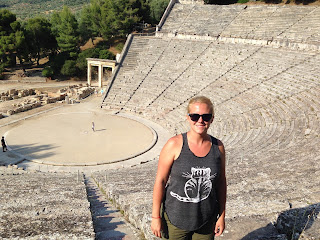In Nafplio we stayed in an apartment that we arranged
through Airbnb. The lady renting out the apartment met us at the bus stop
and drove us to the room! It was a nice gesture and very much appreciated. The
apartment was small but had a little stove top, a balcony, and a bed. Through
our travels, we have realized how little space is actually required to live (at least while traveling).
Nafplio is a popular weekend destination for Athenians and we really enjoyed it as well.
The Palamidi Fortress is the main attraction here, built by the Venetians in the late 1600's on a large hill. Our first day we climbed the 913 steps to the top of the fortress and wandered around for a few hours. Then,
due to a limited bus schedule, we visited the two nearby archaeological sites
the next day (originally we had planned to see one a day). With our sightseeing accomplished in one day, our last full day in Nafplio we went for a run along the coast, took a boat out to an island castle, and sat in a café with wifi access and ate amazing loukomades (Greek donuts) for a while.
A panoramic view from the top of Palamidi
Blue upon blue
I don't know if I would mind being a soldier stationed here
The Greek flag blowing in the wind
Mycenae was the first place we visited. Mycenae is a UNESCO
World Heritage Site, and was one of the first capitals of the ancient Mycenean
civilization in the 2nd century BC. There is very little left to amount to anything substantial
but, walking along the path and seeing the ruins of a palace, temples and even
some graves, Jared and I postulated on what a person who lived there would
think if they were to return today. Obviously they would be in disbelief at some
of the modern inventions, but to see the remains of their home from 3000 years
ago would be pretty surreal as well.
The Lion Gate, one of the earliest known instances of monumental architecture and the largest remaining sculpture in prehistoric Greece.
The surrounding hills were beautiful, and it easy to see why the Myceneans made this place the center of their empire
Some of the ruins nestled in the hills
Our second stop of the day was to Epidaurus. This area is famed
for the huge and largely intact theater. This theater can accommodate up to 13,000
people, and the acoustics are near perfect even by modern day standards. There is a festival
here every year and different performances take place at the theater. Of course it started the day after we were there. Hmpf, stupid public buses with no
buses on Sunday. The nearby village that spurred the creation of the theater
was dedicated to the god Asklepios. This was the healer god, and amongst the
ruins there was evidence that there was a ‘hotel’ area where patients and families
could stay while they were seeking the healing powers of the god. However, among this rather
large area of ruins, our favorite part was the remains of an ancient church.
The walls were still standing in places, and there was a stone slab
altar (we assume it was erected some time in recent history). It
was separate from the other ruins, so it was more peaceful, and the shape and architecture of
the church was still evident.
Part of the ancient hotel area
The little church we discovered and chose as the site of our picnic
Jared in the center of the stage
Looking down from the audience
As I mentioned, for our last day in Nafplio we took it easy. As
much as we enjoy adventuring and exploring we have also come to really treasure
these days. Days where we can just ‘hang out’ in a city without anything specific
on the agenda. It is refreshing and often leads us to new, unexpected
experiences.
I would be much more motivated to run if this were my path everyday
Isn't it a charming city?
We left Nafplio the morning of June 1 to head to our first
Greek island adventure!













No comments:
Post a Comment